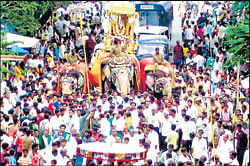
Due to the efforts of the district administration, the tradition was revived in the erstwhile capital of Mysore under the Wadiyars, in 2008. But the funds provided by the government was a meagre Rs one lakh. It was increased to Rs 10 lakh in 2009 and Rs 25 lakh in 2010. It was hoped that the event would get some fillip in the fourth centenary year in 2010. But the only grace was that the procession got a facelift with the Mysore Dasara committee lending elephants and horses. A mantap similar to the golden howdah with an idol of Chamundeshwari was taken out in a procession on elephant Abhimanyu accompanied by folk art troupes.
Govt grants
This year the district administration sought Rs one crore from the government for holding Dasara on a grand scale. But again only Rs 25 lakh has been granted. MLC Ashwathnarayan and MLA Ramesh Bandisiddegowda said efforts were on to seek an additional Rs 50 lakh, at a preliminary meeting held on Saturday.
The meeting was held to seek opinion of the public about holding festivities and was attended by deputy commissioner P C Jaffer, assistant commissioner G Prabhu, tahsildar Arul Kumar, people’s representatives and officials.
Ramesh said the festivities would begin on September 30 at Bannimantap — near Kirangur on the Mysore-Bangalore highway — with a colourful procession. The festivities would conclude on October 4. He said efforts were on to invite president of the last Kannada Sahitya Sammelana G Venkatasubbaiah, whose native place is Ganjam on the island of Srirangapatna.
Raja Wadiyar started the tradition of celebrating Navaratri for 10 days (Dasara) in Srirangapatna, the then capital of Mysore, on the lines of Vijayadashami celebrated in Hampi by Vijayanagara kings. It was celebrated here till 1761. Later, when the capital was shifted to Mysore, and the state was returned to Wadiyars in 1799, the tradition in the temple town continued in a small way. An utsav was taken out from Sri Ranganathaswamy temple to Bannimantap. Even this tradition was stopped a decade ago. The banni tree (Prosopis spicigera) was also cut down some years ago. Now, a new sapling of banni tree has been planted by the family which takes care of the mantap.
Deputy commissioner Jaffer clarified the claim by some private persons over the land on which the Bannimantap stands does not hold water. He said there was no doubt that the land belongs to the government. He responded positively to the demand by the public to protect, conserve and illuminate Bannimantap.
Cultural events
Ramesh said the festivities include cultural programmes by artistes of international fame as well as local artistes, a theatre festival, poets’ meet, sports meet and wrestling.
As Dasara happens to be observed during monsoon, the make-shift stage and pandal that was used for cultural programmes last year did not go well with the public. They urged for a permanent open air theatre and a water-proof pandal. Some women pointed out that there were no public toilets in the vicinity of Sri Ranganathaswamy temple.
Traders and hoteliers had not responded positively to the district administration’s call to participate in celebrations last year. So MLA Ramesh called upon them to at least illuminate their establishments and take up some responsibility voluntarily.